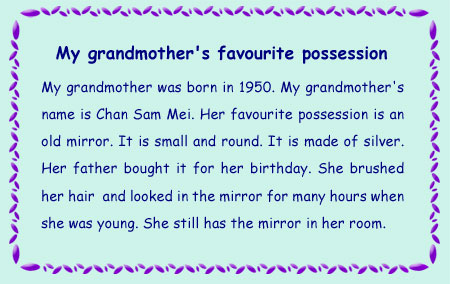| 1. |
Note: |
This is the true story of how the grandfather
clock got its name:
The writer of
the song, Henry Work, often stayed in the same hotel. The hotel had a tall
clock like the one in the picture. The clock belonged to the manager who was
quite old. One time when Henry Work went to the hotel, the
clock had stopped. The hotel staff told him that when the manager died, the clock stopped.
No one could make it work again. Henry Work then wrote the song
and called it My grandfather's clock. It became very popular. From that time on, people
have called
these clocks grandfather clocks.
|
| 2. |
Example: |
| 1. |
Who bought
the clock? |
| 2. |
Why did the clock stand on the floor? |
| 3. |
How old was the grandfather when he
died? |
| 4. |
How does a pendulum move? |
| 5. |
What did the clock do when the
grandfather married?
|
|
| 2. |
Key: |
| 1. |
The grandfather's parents bought the clock
on the day that the grandfather was born. |
| 2. |
The clock stood on the floor because it was
too large to keep on a shelf. |
| 3. |
The grandfather was ninety years old when
he died. |
| 4. |
A pendulum swings from side to side. |
| 5. |
When the grandfather married the clock
struck 24.
|
|
| 3. |
Note: |
Plan your board to look like this:
|
slumbering
numbering
striking
joy
|
making a noise like a bell
feeling happy
sleeping
counting
|
|
|
| 3. |
Key: |
|
| 4. |
Theory: |
Monitoring helps the teacher to identify
problems that need to be dealt with on an individual basis. It also enables the teacher to
make a note of problems that are common to many students. These problems can then be focused on
during whole-class feedback.
|
| 4. |
Key: |
|
| 8. |
Key: |
Question:
Answer: |
What was the grandfather's
favourite possession?
His clock was always his treasure and his pride. |
Question:
Answer: |
What was the clock like?
It was twice as tall as the old man himself. |
Question:
Answer: |
When did his parents buy the
clock?
His parents bought it on the day that he was born. |
Question:
Answer: |
What did he do for many hours
when he was a boy?
He watched its pendulum swing from side to side.
|
|
| 9. |
Example: |
| 1. |
Put up your
hand if your grandfather is living. |
| 2. |
Your
grandfather is one of your relatives. |
| 3. |
Put up your
hand if your grandfather or other older relative lives with you or
nearby.
|
|
| 9. |
Example: |

|
| 9. |
Note: |
Students can ask any older person that they
know. This need not be a relative. They can call this person their
'friend' in the report.
|
| 9. |
Theory: |
It is important for students' motivation to get
them to give personal information using English. This provides an
authentic purpose for communicating, ie because no one else knows about
their relative or friend. It also provides a purpose for listening and
makes the content more interesting for the listeners.
|
| 9. |
Example: |
| What is ...? |
the answer must be |
a thing |
| When did you ...? |
a date or a time |
| What did you do ...? |
an action |
| Where is ...? |
a place |
| Who ...? |
a person |
|
| 10. |
Note: |
The first question on the Interview sheet is given to students as there was no
information about when the grandfather was born in the song. Note also that the
question must use the passive voice. This is unavoidable. However, it is not
necessary for students to learn the term for the passive voice, how it works or
what it is used for. Students can learn this question as a formula rather than
knowing how it is formulated.
|
| 12. |
Note: |
If the older relative knows any English, this
is a good chance for students to show the family what they can do in
English. However, it is accepted that most students will need to use the
mother tongue for this activity. Since the final product of the activity
(the report) will be in English, this is acceptable use of the mother
tongue.
|
| 13. |
Example: |
|
| 13. |
Theory: |
Give students a feeling of pride and satisfaction in what they have
achieved in English by displaying their work in the classroom or other
places in the school. This will enhance students' motivation to learn
English.
|
For more information on using communicative functions for asking for
information, look at the following in PrimeGram:
For more information on using communicative functions for talking about who or what is
involved, look at the following in PrimeGram:
For more information on using communicative functions for talking about what is happening, look at the following in PrimeGram:
